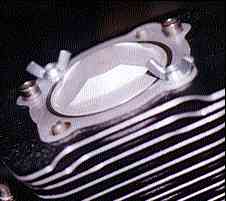Performance and Technical
information on cylinder heads, valves, valve sizes, valve springs, port size, port shapes
and compression ratios for Harley-Davidson motorcycles.Compression Ratios
Increasing the compression ratio of an engine is one of the
best ways to increase horse power and torque. There are three basic ways this can be done.
 | Mill the heads to increase the compression ratio. This is a
simple, easy way to increase the compression of the engine without having to disassemble
the top end.
For street engines with bolt-in cams, limit the milling to .050 inches. When the engine is
assembled, use one of the .030 inch thickness head gaskets instead of the normal .040 or
.060 inch gaskets. This will give the engine a mechanical compression ratio of almost
9.5:1. This is considered the minimum compression ratio needed to make serious power
from a Harley-Davidson engine. |
| Mill Heads |
Compression
Ratio
for 80 CID Evolution |
Compression
Ratio
for TC88 |
Compression
Ratio
for TC95 |
OEM TC
Head/Gasket cc's |
| .000" |
8.50 |
9.00 |
9.5 |
90 |
| .020" |
8.77 |
9.33 |
9.9 |
87 |
| .040" |
9.07 |
9.69 |
10.3 |
83 |
| .060" |
9.39 |
10.09 |
10.7 |
80 |
| .080" |
9.73 |
10.52 |
11.1 |
76 |
| .100" |
10.01 |
11.00 |
11.7 |
72 |
Static Engine Compression
When modifying an engine, it is important to match the
compression ratio with the duration of the cam. While additional cam duration can produce
more useable power, to much duration can hurt the performance. The problem is created when
too much duration results in lower cylinder compression pressures at low RPM which reduce
the low RPM torque and power.
Below is a chart that provides guidelines for engine performance for a given range of
static compression pressures. These should provide a good means of judging if the cam
installed in the engine matches the other components.
| Static Cranking Pressure |
Performance Implications |
| Less than 115 PSI |
Poor low speed performance, poor throttle
response, hard starting. Compression Ratio and Cam not matched or worn rings, valves. |
| 120 PSI to 145 PSI |
Expected range for most stock or modified
street motors. This is a good range for a street motor. |
| 145 PSI to 165 PSI |
Modified street motors. Static pressures in
this range should produce good results. This is a good range for a street motor. |
| 165 PSI to 180 PSI |
Marginal for street motors. Possible hard
starting, detonation and overheating. |
| Over 180 PSI |
These are all out race engines. A street motor
in this range will be trouble. Stick to the track. |
|

